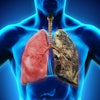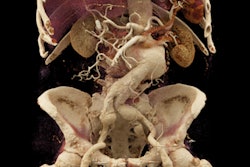CHICAGO - A differential diagnosis of acute thoracic aortic injuries (ATAI) must be based on many factors. At the department of diagnostic imaging in Naples, Italy, Dr. Mariano Scaglione and his colleagues have achieved a 100% positive predictive value in assessing ATAI with contrast-enhanced helical CT. Scaglione presented their results at the RSNA meeting on Sunday.
Scaglione and his team reviewed the results of 1,419 consecutive contrast-enhanced helical CT scans of the chest that were performed in the setting of major blunt trauma over three years. The helical CT scans were performed after intravenous injection of nonionic contrast material with the following major parameters:
- 3 ml per second rate for a total of 120 ml of contrast
- a 25 second delay
- 1.4 pitch
The researchers determined that the following CT findings were at least indicative of ATAI: intimal flap, pseudoaneurysm, contour irregularity, lumen abnormality, or extravasation of intravenous contrast material.
According to the results, 77 patients had abnormal CT scans. Of these, 23 patients had direct CT signs, and ATAI was confirmed in 21 when they underwent thoracotomy. The group also tracked 1,396 patients who had negative CT scans. The patients were included in an 8-month follow-up program and did not show adverse signs on the basis of both clinical and radiographic criteria.
Contrast-enhanced helical CT results had a sensitivity of 92%, a specificity of 100%, a positive predictive value 100%, a negative predictive value of 99.8%, and an accuracy of 99.8%.
Scaglione noted that there are potential pitfalls to this method that should be considered, such as ductus diverticulum, aortic dissection, aortic ulceration, artifacts, and small injuries. Other modalities, such as aortography, may better clarify diagnosis.
On the basis of the results of this three-year investigation, the group concluded that direct CT signs do not require further confirmatory diagnostic investigations in a diagnosis of ATAI. Scaglione observed that aortic injuries are always associated with at least minimal mediastinal hematoma; conversely, when mediastinal hematoma is absent, aortography is recommended to avoid pitfalls or to prove alternative diagnosis.
Although the research clearly demonstrated that contrast-enhanced helical CT has a critical role in the exclusion of ATAI and prevents unnecessary aortography, Scaglione recommended aortography in cases of isolated medium mediastinal hematoma regardless of a negative CT.
By Jonathan S. Batchelor
AuntMinnie.com staff writer
November 25, 2001
For the rest of our coverage of the 2001 RSNA meeting, go to our RADCast@RSNA 2001.
Copyright © 2001 AuntMinnie.com




















